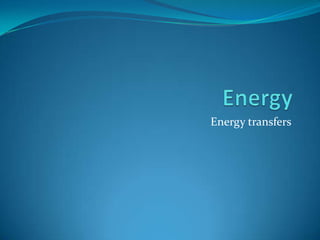
Energy transfers of a dropped ball
- 2. Case 1: Energy transfers of a dropped ball A falling ball transfers gravitational potential energy into kinetic energy When the ball hits the ground,its shape changes and the kinetic energy is transferred into elastic potential energy As its shape is restored, the elastic potential energy changes back into kinetic energy As the ball gets higher in the air, kinetic energy is transferred back into gravitational potential energy
- 3. Case 1: Energy transfers of a dropped ball When the ball bounces back up into the air, it does not go up to the same height at which it started.With each of the above transfers of energy, some of he energy is wasted as heat. In stage 1 energy is lost because of air resistance. When the ball collides with the air molecules, both the ball and the air are made a little warmer. In stage 2 energy is lost when the ball changes its shape and the ball becomes warmer.Stage 2 also loses energy as sound when the ball hits the ground. Stage 3 loses energy for the same reason as stage 2. Stage 4 loses energy for the same reason as stage 1. If the energy transfers were perfect and there were no energy losses,the bouncing ball would always return to the same height at which it started.It would carry on bouncing like this forever.This would be called "perpetual motion".Perpetual motion does not exist because there are always energy losses during transfers.
- 4. Case 2: Dropping a tennis ball on top of basketball When the basketball hits the ground it gets pushed back up, and then the tennis ball collides with the basketball. The basketball pushes the tennis ball away and transfers some of the basketball's kinetic energy to it. If the basketball gave some of its energy to the tennis ball, why did it bounce to about the same height as before?
- 5. Case 2: Dropping a tennis ball on top of basketball Because the weight or mass of an object has a lot to do with most how much energy it has. If the basketball and tennis ball are moving at the same speed, the basketball has a lot more energy than the tennis ball because it has a lot more mass. So when the basketball gave energy to the tennis ball, the basketball only lost a little bit of speed for the same amount of energy that it took to give the tennis ball a lot of extra speed.
- 6. Case 3: Dropping a basketball on top of tennis ball When the balls collided, the tennis ball didn’t even have enough momentum to push the basketball back up The tennis ball just slowed the basketball down a little bit before it could hit the ground Therefore the basketball didn’t even bounce up to the original height it was dropped from.
- 7. CalculatingGravitationalPotentialEnergy First, youmustunderstandthedifferencebetweenmass and weight: Mass is an amount of substance. It is measured in kilograms. It tells you how many particles (atoms, ions or molecules) you have, not what they weigh. Weight is the force of gravity pulling on a mass.Weight is a force, and so it is measured in Newtons, not kilograms. Weight = mass x gravity On Earth the force of gravity is 10 N/kg.
- 8. CalculatingGravitationalPotentialEnergy Calculatetheweight of thefollowingobjects: A manweighting 100 kg: A 5 kg watermelon: A girlwhoweights 47 kg:
- 9. CalculatingGravitationalPotentialEnergy Tocalculatethegravitationalpotentialenergy of anobject use thefollowingequation: GPE = mass (kg) x gravity (N/ kg) x height (m) Or, becauseweight = mass x gravitywe can also use thefollowing: GPE = weight (N) x height (m) Question: Whatistheunit of measurementfor GPE?
- 11. Case 1: Energy descriptions of a dropped ball When the ball is held up, it has a lot of potential energy and no kinetic energy. As it falls, it starts losing it's potential energy and speeds up to get more kinetic energy. When it hits the floor it has no potential energy, but lots of kinetic energy. When the ball hits the ground, it gets squashed, which causes friction between the different rubber molecules that make up the ball, and the friction heats the ball up. The ball has lost some kinetic energy and has gained thermal energy. When we see the ball bounce back up almost to its original height, we know that it is always a little bit lower than it started because it has transformed some of that original potential energy to thermal energy.
- 12. The law of conservation of energy Energy can be transferred in more than one form at a time. The INPUT energy will always equal the total OUTPUT energy. “Energy cannot be created or destroyed. It can only be changed from one form to another.”
- 13. Kinetic energy 58% (Useful spinning of the drill bit) Energy Transfer Values Electrical energy 100% Kinetic energy 22% (Wasted vibration of the drill) Heat energy 20% (wasted)